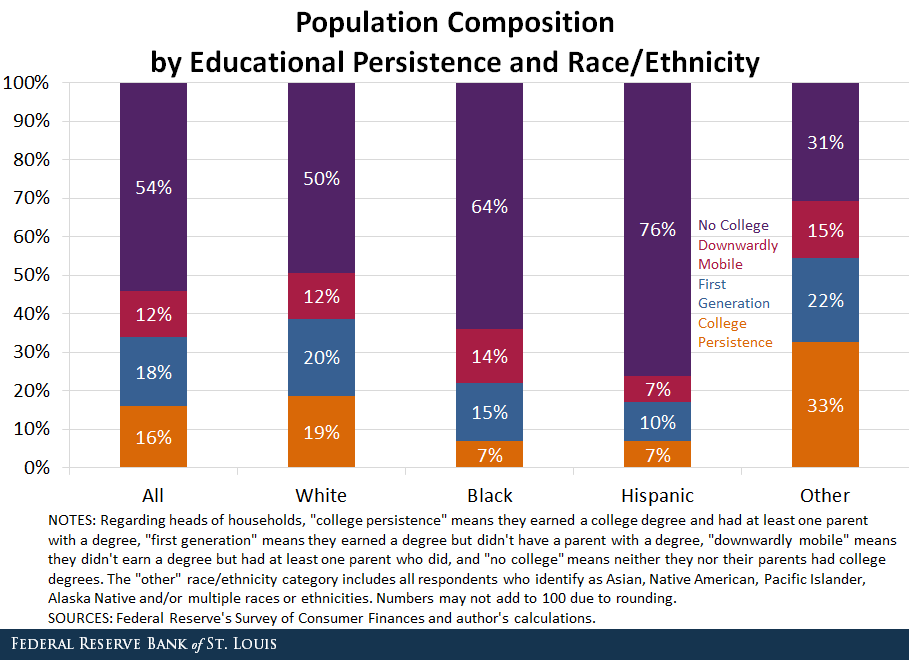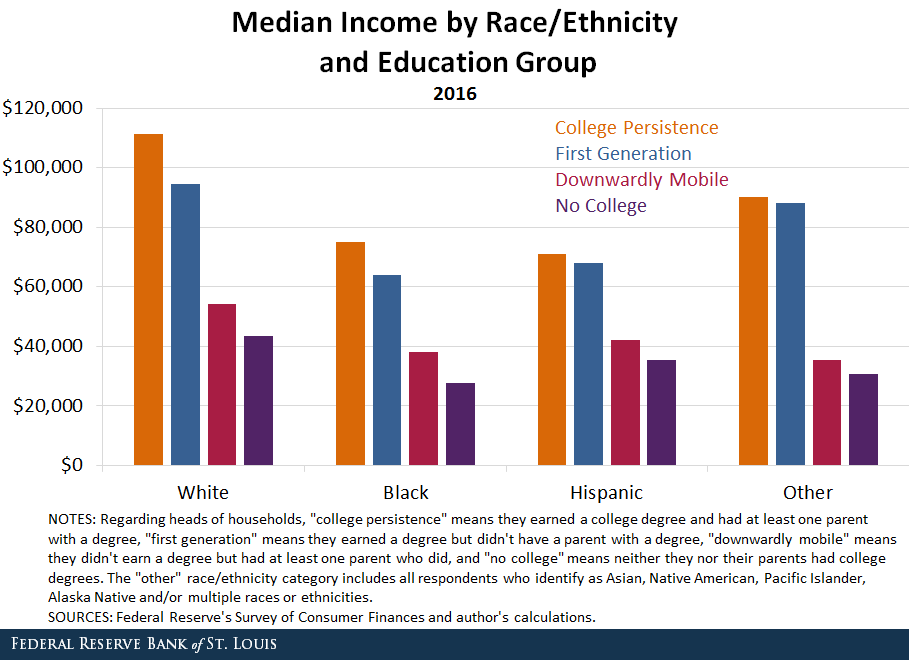Staff Pick: College Education Persists Less for Blacks and Hispanics
The On the Economy blog will periodically rerun blog posts that were of particular interest. The following is a post from February 2019 by Ana Hernández Kent on college persistence among black and Hispanic families.
Educational attainment tells us quite a bit about the types of financial outcomes we should expect a family to have. So does the education of the family’s parents. In the following analyses, education refers to the family head’s education level, and parents refers to the parents of the family head. Unsurprisingly, most people tend to achieve the same level of education as their parents, with college “persisters” (college graduates for whom at least one parent was also a college grad) having the best financial outcomes. The sources for all numbers are the Federal Reserve’s Survey of Consumer Finances and my calculations.
The good news is that over half of family heads get a college degree if a parent did. The bad news is that only a quarter of family heads do so if neither parent achieved a four-year degree. Racial differences in intergenerational educational persistence are even more pronounced. Exploring these differences is important, because college graduates have larger incomes and more wealth than nongrads. Emmons, William R.; Kent, Ana H.; and Ricketts, Lowell R. “The Financial Returns from College across Generations: Large but Unequal.” The Demographics of Wealth 2018 Series, Federal Reserve Bank of St. Louis, February 2018, Essay No. 1.
Intergenerational Educational Persistence by Race
Intergenerational educational persistence varies sharply by race/ethnicity, as seen in the table below.
| Head of Household's Education | |||||||
|---|---|---|---|---|---|---|---|
| White | Four-year degree | No degree | |||||
| Parents' Education | Four-year degree | 60% | 40% | ||||
| No degree | 28% | 72% | |||||
| Black | |||||||
| Parents' Education | Four-year degree | 34% | 66% | ||||
| No degree | 19% | 81% | |||||
| Hispanic | |||||||
| Parents' Education | Four-year degree | 49% | 51% | ||||
| No degree | 12% | 88% | |||||
| Other | |||||||
| Parents' Education | Four-year degree | 69% | 31% | ||||
| No degree | 41% | 59% | |||||
| SOURCES: Federal Reserve's Survey of Consumer Finances and author's calculations. | |||||||
Blacks had the lowest intergenerational college persistence. If at least one parent had a degree, only 1 in 3 continued to get a college degree themselves. This contrasts sharply with the group of other races/ethnicities, The group of other races/ethnicities includes all respondents who self-identify as Asian, Native American, Pacific Islander, Alaska Native, and multiple races/ethnicities. for which 7 in 10 persisted in achieving a college degree when a parent had done so.
Intergenerational no-college persistence also showed marked racial differences. Hispanics had the highest no-college persistence, with just under 9 in 10 not achieving a four-year degree if neither parent did. That contrasts with the group of other races/ethnicities, which had the lowest rate of no-college persistence: Roughly 3 in 5 failed to graduate from college if their parents didn’t.
Intergenerational Educational Attainment
Looking broadly at overall levels of intergenerational educational attainment, race/ethnicity is also clearly important to consider, as seen in the figure below.

College persisters ranged from 7 percent to 33 percent depending on race. First-generation families (college grads whose parents did not get a degree) and downwardly mobile families (those who had a college-graduate parent but did not earn a degree) were a little more consistent across race, but no-college (in either generation) families again fluctuated quite a bit, from 31 percent in the group of other races/ethnicities to 76 percent of Hispanics.
These numbers suggest that college attainment still varies greatly depending on race/ethnicity and parental education. Moreover, intergenerational college persistence is quite difficult to achieve for blacks and Hispanics: They were roughly one-third as likely to be college persisters as whites.
College Persisters Thrive (Especially When White)
Low intergenerational college persistence for blacks and Hispanics is concerning given that college grads have more favorable financial outcomes. Emmons, William R.; Kent, Ana H.; and Ricketts, Lowell R. “The Financial Returns from College across Generations: Large but Unequal.” The Demographics of Wealth 2018 Series, Federal Reserve Bank of St. Louis, February 2018, Essay No. 1. As can be seen in the figure below, college persisters indeed thrived, earning a higher median income compared to all other education families of the same race/ethnicity.

Downwardly mobile families also earned more than the no-college group, pointing to the importance of parental education.
While within-race/ethnicity intergenerational educational patterns are important, between-race/ethnicity patterns are also tremendously informative. Whites in general have better financial outcomes than minorities. Emmons, William R.; Kent, Ana H.; and Ricketts, Lowell R. The Bigger They Are, The Harder They Fall: The Decline of the White Working Class. The Demographics of Wealth 2018 Series, Federal Reserve Bank of St. Louis, September 2018, Essay No. 3. For example, while the typical black and Hispanic college persisters’ incomes were larger than all other same-race educational groups,’ they were actually 21 percent and 25 percent smaller, respectively, than the typical income of a white first generation head of household.
Comparing families with the same intergenerational education yielded noticeable differences as well. Among families with college in at least one generation, the white/black and white/Hispanic racial income gaps were largest for persister families:
- Black persisters’ median income was 33 percent smaller than the typical white college persister’s income.
- This figure was 36 percent for Hispanics. First-generation and downwardly mobile black median incomes were 32 and 30 percent smaller, respectively, than first-generation and downwardly mobile white median incomes. Those figures were 28 and 23 percent, respectively, for Hispanics.
College graduate families had higher incomes than nongrad families. However, holding the household head’s education constant, those with a college-graduate parent earned more. Drawing from these results suggests that families of all races would benefit from increased college persistence as well as a rupture of the intergenerational no-college pattern. Black and Hispanic families in particular have larger educational persistence hurdles to overcome. An increased focus on why college—even intergenerational college achievement—does not narrow the racial income gap is warranted.
Notes and References
1 In the following analyses, education refers to the family head’s education level, and parents refers to the parents of the family head.
2 The sources for all numbers are the Federal Reserve’s Survey of Consumer Finances and my calculations.
3 Emmons, William R.; Kent, Ana H.; and Ricketts, Lowell R. “The Financial Returns from College across Generations: Large but Unequal.” The Demographics of Wealth 2018 Series, Federal Reserve Bank of St. Louis, February 2018, Essay No. 1.
4 The group of other races/ethnicities includes all respondents who self-identify as Asian, Native American, Pacific Islander, Alaska Native, and multiple races/ethnicities.
5 Emmons, William R.; Kent, Ana H.; and Ricketts, Lowell R. “The Financial Returns from College across Generations: Large but Unequal.” The Demographics of Wealth 2018 Series, Federal Reserve Bank of St. Louis, February 2018, Essay No. 1.
6 Emmons, William R.; Kent, Ana H.; and Ricketts, Lowell R. "The Bigger They Are, The Harder They Fall: The Decline of the White Working Class." The Demographics of Wealth 2018 Series, Federal Reserve Bank of St. Louis, September 2018, Essay No. 3.
7 First-generation and downwardly mobile black median incomes were 32 and 30 percent smaller, respectively, than first-generation and downwardly mobile white median incomes. Those figures were 28 and 23 percent, respectively, for Hispanics.
Additional Resources
Citation
ldquoStaff Pick: College Education Persists Less for Blacks and Hispanics,rdquo St. Louis Fed On the Economy, Nov. 12, 2019.
This blog offers commentary, analysis and data from our economists and experts. Views expressed are not necessarily those of the St. Louis Fed or Federal Reserve System.
Email Us
All other blog-related questions

